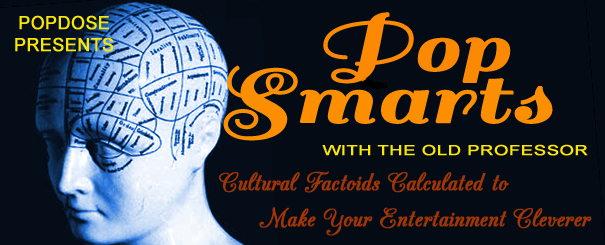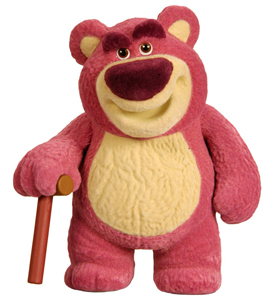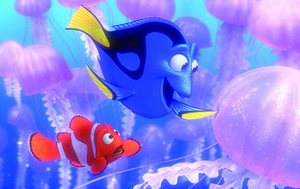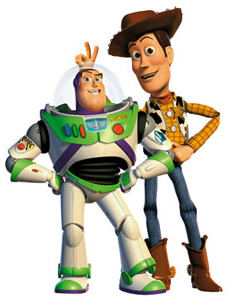
It’s not a revelation to anyone, anymore, to point out that Hollywood is no longer in the business of original ideas. It takes a great deal of money to make and market a movie — any movie. And the Powers That Be have long ago figured out that the best way to ensure a return on their investment is to make films that are pre-sold, inasmuch as such a thing is possible — that is, movies with built-in name recognition: adaptations, sequels, reboots, reimaginings. Movies where name recognition alone will be enough to put butts in seats. Everybody does it, simply because it minimizes the colossal risks of filmmaking. It’s just smart business sense.
So it is not unexpected — but still disappointing — to see Pixar fall into line behind this conventional wisdom. From its 1995 debut feature Toy Story onward, the computer-animation studio has mostly concentrated on making original films. Of the ten movies put out by Pixar between 1995 and 2009, only one was a sequel; and yet all were immensely profitable.
 Pixar’s model for market domination was learned from its parent company, Disney. Their films relied on name recognition, the same as anybody else’s — but the name that drew audiences was their own. The Pixar brand itself was enough to fill theaters. The studio built that name simply by setting and maintaining an extraordinarily high standard of quality for its movies. Even a lesser Pixar film guaranteed an entertaining afternoon at the movies, while a handful — Monsters Inc., The Incredibles, Wall-E — approached classic status.
Pixar’s model for market domination was learned from its parent company, Disney. Their films relied on name recognition, the same as anybody else’s — but the name that drew audiences was their own. The Pixar brand itself was enough to fill theaters. The studio built that name simply by setting and maintaining an extraordinarily high standard of quality for its movies. Even a lesser Pixar film guaranteed an entertaining afternoon at the movies, while a handful — Monsters Inc., The Incredibles, Wall-E — approached classic status.
That’s why it’s disheartening for Pixar to turn away from the risk-taking original storytelling that made their name, and towards the safer formula of franchising. Two of Pixar’s last three movies (2010’s Toy Story 3 and 2011’s Cars 2) have been sequels, and their slate of upcoming projects includes both a Monsters, Inc. prequel and a follow-up to Finding Nemo. The relatively lackluster performance of their last original feature, Brave, will likely only make studio executives more risk-averse — and Pixar’s absorption into the standard Hollywood economic model will be complete.
In its early years, Pixar took a hard-nosed attitude towards franchises. Quality was their brand, and they were reluctant to dilute it. There was an explicit directive that no sequel would go out under the Pixar brand unless it met or exceeded the standards of the original work. (That being said, Pixar’s complicated relationship with their distributor Disney gives the latter the right to produce original works based on Pixar properties even without Pixar’s direct involvement, giving us such dubious product as the Buzz Lightyear of Star Command TV series.) That directive effectively kept Pixar sequel-free for its first fifteen years of operation — with the single exception of 1998’s Toy Story 2.
Toy Story 2 belongs on the list of Pixar masterpieces, deepening and enriching the first film’s stylistic innovations and visual wit while finding new emotional shadings. Rather than rehash the themes of the first Toy Story, the sequel kept the setup — sentient toys separated from their young owner must find their way back to him — but found new meanings in the formula. In the original Toy Story, the toys are identification figures for the child audience, and their fears are a child’s fears; losing the affections of your best friend, being lost and left behind. Toy Story 2 flips the script, making the toys surrogates for the parents watching with their kids. They watch with mingled pride and sadness as their children grow up and pull away, outgrow them and leave them behind. The montage set to Sarah McLachlan’s performance of ”When She Loved Me” is a nigh-perfect mini-movie in itself, a heartbreaking narrative of love and loss:
[youtube id=”ElhbTsKsros” width=”600″ height=”350″]The film ends with some hard-won wisdom, with the hard-luck cowboy Woody resolved to enjoy his years with young Andy  while they last, and to give way gracefully when the time comes.
while they last, and to give way gracefully when the time comes.
Toy Story 3 reinvented the main characters and their relationships yet again, turning the setup into a parable for divorce. Separated at last from their owner Andy — who is heading off to college — Woody, Buzz, and the rest of the gang struggle to find new roles after the end of the long relationship that has defined them for years. The toys are donated to a local day-care center, where their rough-and-tumble encounters with the resident toddlers constitute a comic-horrible metaphor for a return to the dating pool. The toys eventually find a new chance at happiness when they are taken home by another young child; the conclusion finds them tentatively building a new family with her. The villain of the piece is Lots-O’-Huggin’, a stuffed bear lost by his owner, who made his way home only to find he had been replaced by another bear, leaving him so bitter and traumatized that he foreswears the love of children entirely.
 The genius of the Toy Story franchise, then, has been in using its iconic characters to address a shifting set of themes and concerns. The upcoming sequel to Finding Nemo has the potential to do much the same. Where the original — the tale of a young clownfish separated from his anxious father — centered on the fears of an overprotective single parent, the sequel will spotlight Ellen DeGeneres’ character, Dory — a regal blue tang with short-term memory loss. Although Dory’s affliction was inspired by the old myth that goldfish’s memories persist for only a few seconds (which is untrue, by the way; studies indicate that most species have a memory-span of at least three months), it has obvious metaphorical applications, and it’s easy to imagine Finding Dory resonating with the parents — and especially the grandparents — of its child audience, as they contemplate losing their own loved ones to Alzheimer’s and dementia.
The genius of the Toy Story franchise, then, has been in using its iconic characters to address a shifting set of themes and concerns. The upcoming sequel to Finding Nemo has the potential to do much the same. Where the original — the tale of a young clownfish separated from his anxious father — centered on the fears of an overprotective single parent, the sequel will spotlight Ellen DeGeneres’ character, Dory — a regal blue tang with short-term memory loss. Although Dory’s affliction was inspired by the old myth that goldfish’s memories persist for only a few seconds (which is untrue, by the way; studies indicate that most species have a memory-span of at least three months), it has obvious metaphorical applications, and it’s easy to imagine Finding Dory resonating with the parents — and especially the grandparents — of its child audience, as they contemplate losing their own loved ones to Alzheimer’s and dementia.
But while Pixar’s characters are semantically versatile, they are not infinitely so, and the films have been subject to any number of far-fetched interpretations. One reading of the original Toy Story, in particular, has proved as durable as it is wrong-headed: the notion that the film is a coded argument for an atheist worldview.
Now, you can see where a person might lean towards that conclusion, depending on the baggage they brought to the film. Atheism as a philosophical argument is not often expressed in popular entertainment. The cult favorite Cube made it; but of recent mainstream movies, only The Matrix and The Truman Show really spring to mind (although in both cases the message is a bit muddled, coming off more as, ”God exists, but He’s kind of an asshole”). And there have long been rumors that Walt Disney himself was an atheist, which, although largely without basis — according to his biographers, Disney always considered himself a Christian, so if skipping church on Sundays makes him an atheist, then so is George W. Bush — have nonetheless left made it tempting for secular humanists, eager to claim him for their own, to inspect the films coming under his corporate banner for hints of a godless philosophy.
Undeniably, one strain of Toy Story’s plot does follow a revelation or conversion narrative. The self-deluding Buzz Lightyear spends most of the film believing that he is a real space ranger, not a child’s plaything; and no amount of well-meaning, exasperated argument from the other toys can open his eyes to the true nature of reality.
So, yeah, if you enter into the film with a certain set of preconceived notions, you can see how that might be an idea that you might have. Of course, I might give the thesis more credence were it not for the nature of Buzz’s revelation.
Because the shattering truth that Buzz discovers over the course of the film — the truth Woody already knows — is that he and his fellow toys are not alone in the universe; that they are not autonomous and self-determining beings after all, but rather that they are beloved of and protected by, that they serve and are served by, that they are created to love — and to be loved by — what is from their perspective a huge and all-powerful entity, one who literally holds them in the palm of his hand, who has called them each by name, who has set his seal upon them: and that all their illusory activities in this world are vain and pointless, and that the way to true fulfillment is to surrender oneself to the service and trust of this benevolent entity.
Of course, as science fiction grandmaster Gene Wolfe says, ”Any interesting work of art comes close to saying the opposite of what it really says.” But when determining what is real and what is opposite, it helps to look at the specifics of the evidence, and not just the shape of the argument. After all, as the old proverb tells us, God is in the details.





Comments